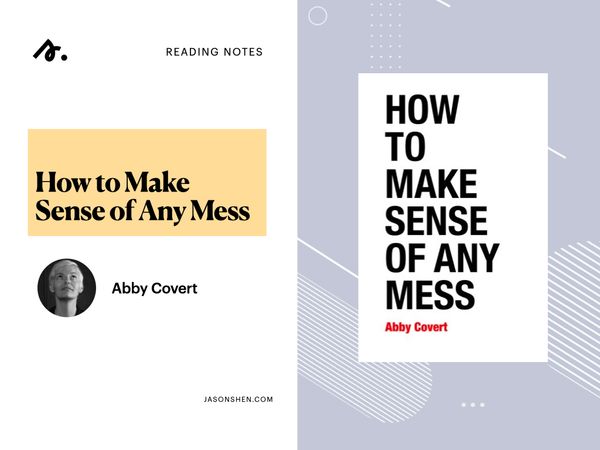Reading Notes on Abby Covert's How to Make Sense of Any Mess
The Book in a Nutshell: The human race is creating more information than ever before, in the form of signs, articles, websites, apps, and much more — and the world would be a better place if we could all learn a little bit more about how to structure, present, and discuss that information. Also one of the inspirations for How to Get What You Want.
About the Author: I first encountered Abby Covert via a presentation she did with the same name as part of the Blend 2014 conference. She’s the President of the Information Architecture Institute and teaches IA at the Parsons New School of Design. I loved her story-driven, no-nonsense approach to writing about this field and years later she later consulted with Etsy on its website UX which was super cool.
Key Quotes and Insights
1. “The most important thing I can teach you about information is that it isn’t a thing. It’s subjective, not objective. It’s whatever a user interprets from the arrangement or sequence of things they encounter.”
This is a crucial element of the book. Abby defines data as a collection of facts and observations about something, and information as the interpretation of that data. According to this definition, information is subjective, and therefore open to different points of view depending on where you’re coming from. This fact is what complicates communication.
2. “Intent is language … Our language choices change how we use our time and energy. For every word we use to describe where we want to go, there’s another word we are walking away from”
Words matter and selecting the right word focuses our understanding of what we’re making. In Abby’s words, if we’re working toward a video game, we are moving away from building an amusement park. If a product should be simple, that forces it away from being complicated. Focus is good, and selecting the words we use (and don’t use) matter.
3. “What we intend to do determines how we use words like good and bad. … Without a clear definition of what good means, bad can come out of nowhere.”
We all tend to have strong reactions to the things we’re presented, whether that’s an app, a meal, an article, a piece of furniture. And it’s easy to jump ahead and say the negative reactions indicate that whatever we’re looking at is bad. But we have to define good and bad before we can label anything as such.
4. “Understanding the why behind what you’re making allows you to uncover your intent and potential. When everyone knows why they’re doing something, the way forward is clearer and each person can understand their individual responsibilities.”
Related to idea of understanding what your goals are, making sure you all understand why you’re working on your projects, who it matters for, and what effect it will have on them can be powerful motivators. Clarity leads to purpose.
5. “Objects let us have deeper conversations about reality. When you discuss a specific subject, you subconsciously reference part of a large internal map of what you know. Other people can’t see this map. It only exists in your head, and it’s called your mental model. We create objects like maps, diagrams, prototypes, and lists to share what we understand and perceive. Objects allow us to compare our mental models with each other.”
I learned this in my last role at the Smithsonian. Creating even simple wireframes and mockups beats the pants out of having a long hand-gesture powered conversation about an idea. We are visual beings and diagrams and sketches really go a long way increasing understanding.
6. “The first step in understanding how something is performing is to measure it as it is. A baseline is the measurement of something before changing it. Without baselines, assumptions will likely lead us in the wrong direction.”
It’s so easy to get wrapped in how our next big thing is going to sweep the internet, or at the very least, blow the pants off the old version. Collecting good baselines and comparing is the best way to get back in touch with reality.
7. “Flags tell us if we’re headed in the right direction. Flags are useful because they allow us to know when something important happens. We can attach a flag to most indicators.”
As we start measuring and monitoring the state of our stuff, we can use flags, or what Dan and Chip Heath might call “tripwires” to keep us notified of important changes to our project, our application, our lives. Flags include letting me know the download is complete, getting a text when my Lyft driver is here, or getting my pay stubs in the mail.

